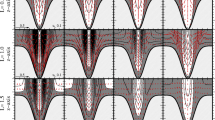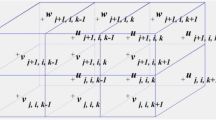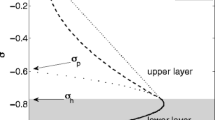Abstract
A local, one-dimensional, depth-dependent model is used in conjunction with a one-dimensional, longitudinal, hydrodynamical model to examine the mechanisms affecting yertical profiles of longitudinal residual current in the macrotidal (tidal range typically exceeds 4 m during spring tides), partly-mixed Tamar Estuary. Residual currents are simulated at a deep (15m) station in the lower reaches, which possesses a small tidal amplitude to depth ratio and a nonzero salinity throughout the tidal cycle, as well as at a shallow station in the upper reaches, which varies in depth from 1 m at low water, when salinity is zero, to 5 m at high water. A slow, up-estuary current dominates the residual circulation just beneath the high-water level at the deeper station. Further down the water column a down-estuary residual current develops which is the near-surface component of a two-layer gravitational circulation. The up-estuary component of this gravitational circulation occurs deeper in the column and extends to the bed at the deep station, whereas at the shallow station it is eventually dominated by a down-estuary current in the bottom 1 m. Simulated residual currents are fairly insensitive to estuary-bed slope and to observed depth variations in longitudinal density gradient. Residual current profiles of the observed form can only be generated by a longitudinal density gradient. The reduction in vertical eddy viscosity by water column stability due to stratification is an essential requirement for producing a strong gravitational circulation of the observed magnitude. Stratification at the shallow station is much higher during the ebb than during the flood and this asymmetry enhances the gravitational circulation in the upper reaches. The formation of residual flows at both stations is illustrated by showing time-series data over a tidal cycle for the simulated current profiles.
Similar content being viewed by others
Literature Cited
Bowden, K. F. andP. Hamilton. 1975. Some experiments with a numerical model of circulation and mixing in a tidal estuary.Estuarine and Coastal Marine Science 3:281–301.
Davies, A. M. andG. K. Furnes. 1980. Observed and computed M2 tidal currents in the North Sea.Journal of Physical Oceanography 10:237–257.
Dyer, K. R. 1973. Estuaries: A Physical Introduction, John Wiley and Sons, New York, 140 p.
Fischer, H. B., E. J. List, R. C. Y. Koh, J. Imberger andN. H. Brooks. 1979. Mixing in Inland and Coastal Waters. Academic Press, New York. 484 p.
Hansen, D. V. andM. Rattray. 1966. New dimensions in estuary classification.Limnology and Oceanography 11:319–326.
Huang, P.-S., D.-P. Wang, andT. O. Najarian. 1986. Analysis of residual currents using a two-dimensional model, p. 71–80.In J. van de Kreeke (ed.), Lecture Notes on Coastal and Estuarine Studies. Spring-Verlag, New York.
Ianniello, J. P.. 1977. Tidally-induced residual currents in estuaries of constant breadth and depth.Journal of Marine Research 35:755–786.
Ianniello, J. P.. 1977. Tidally-induced currents in estuaries of variable breadth and depth.Journal of Physical Oceanography 9:962–974.
Lehfeldt R. andS. Bloss. 1988. Algebraic turbulence model for stratified tidal flows, p. 278–291.In J. Dronkers and W. van Leussen (eds.), Physical processes in Estuaries. Springer-Verlag, New York.
Longuett-Higgins, M. S. 1969. On the transport of mass by time-varying ocean currents.Deep Sea Research 16:431–447.
McGregor, R. C. 1972. The influence of eddy viscosity on the vertical distribution of velocity in the tidal estuary.Geophysical Journal of the Royal Astronomical Society 29:103–108.
Munk, W. H. andE. R. Anderson. 1948. Note on the theory of the thermocline.Journal of Marine Research 7:276–295.
Najarian, T. O., D.-P. Wang andP.-S. Huang. 1984. Lagrangian transport model for estuaries.Journal of Waterway, Port, coastal and Ocean Engineering ASCE 110:321–333.
Officer, C. B. 1976. Physical Oceanography of Estuaries (and Associated Coastal Waters). John Wiley and Sons, New York. 465 p.
Rattray, M. andJ. G. Dworski. 1980. Comparison of methods for analysis of the transverse and vertical circulation contributions to the longitudinal advective salt fluxes in estuaries.Estuarine and Coastal marine Science 11:515–536.
Stephens, C. V. 1986. A three-dimensional model for tides and salinity in the Bristol Channel.Continental Shelf Research 6:531–560.
Sternberg, R. W. 1968. Friction factors in tidal channels with differing bed roughness.Marine Geology 6:243–260.
Uncles, R. J., R. C. A. Elliott, S. A. Weston, D. A. Pilgrim, D. R. Ackroyd, D. J. McMillan, andN. M. Lynn. 1986. Synoptic observations of salinity, suspended sediment and vertical current structure in a partly mixed estuary, p. 58–70.In J. van de Kreeke (ed.), Lecture Notes on Coastal and Estuarine Studies. Springer-Verlag, New York.
Uncles, R. J., R. C. A. Elliott andS. A. Weston. 1985. Dispersion of salt and suspended sediment in a partly mixed estuary.Estuaries 3:256–269.
Uncles, R. J. andI. R. Joint. 1983. Vertical mixing and its effects on phytoplankton growth in a turbid estuary.Canadian Journal of Fisheries and Aquatic Sciences 40:221–228.
Uncles, R. J. andM. B. Jordan. 1980. A one-dimensional representation of residual currents in the Severn Estuary and associated observations.Estuarine and Coastal Marine Science 10:39–60.
van Veen, J. 1938. Water movements in the Strais of Dover.Journal Conseil International pour l’Exploration de la Mer 13:7–36.
Viollet, P. L. 1988. On the numerical modelling of stratified flows, p. 257–277.In J. Dronkers and W. van Leussen (eds.), Physical Processes in Estuaries. Springer-verlag, New York.
Wang, D.-P. andD. W. Kravitz. 1980. A semi-implicit two-dimensional model of estuarine circulation.Journal of Physical Oceanography 10:441–454.
West, J. R., K. O. K. Oduyemi, A. J. Bale andA. W. Morris. 1990. The field measurement of sediment transport parameters in estuaries.Estuarine and Coastal Shelf Science 30:167–193.
Author information
Authors and Affiliations
Rights and permissions
About this article
Cite this article
Uncles, R.J., Stephens, J.A. The structure of vertical current profiles in a macrotidal, partly-mixed estuary. Estuaries 13, 349–361 (1990). https://doi.org/10.2307/1351780
Received:
Accepted:
Issue Date:
DOI: https://doi.org/10.2307/1351780




